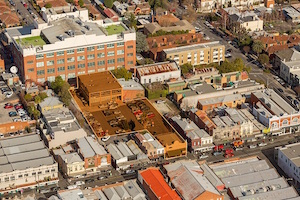
Exclusive: CBD hotels need to adapt and innovate to cater for the ‘new normal’
Op-ed by Ross Beardsell: Based on the latest research should we accept that hotels may not return to the pre-pandemic model for quite some time?
Business and inbound travel have been slow to return to CBD hotels, which is requiring hoteliers to adapt quickly to new market conditions. JLL Hotels and Hospitality’s Ross Beardsell says the latest research suggests that the industry might have to get used to the ‘new normal’ for longer than previously expected.
A Tourism & Task Force (TTF) survey released last week revealed what all city hoteliers already knew – that conditions simply weren’t returning to pre-COVID-19 times and that they would have to adjust to a ‘new normal’. The TTF report, undertaken by DSpark, revealed that the number of city workers and business visitors was still a long way from recovering to 2019 levels.
Our latest AccomNews print issue is available now. Read it HERE
In Melbourne’s case, only 65 percent of CBD workers had returned to the city, while mid-week visitors were at 80 percent of 2019 levels. This was a lot more optimistic than Victorian Chamber of Commerce research, which reported that only 8 percent of workers in March were spending five days in the office.

While Melbourne has always been considered the laggard in the return to the CBD office, the TTF survey revealed that Sydneysiders were just as reluctant to give up their suburban kitchen bench for city work desks, with only 64 percent of workers back in their CBD offices. A consequence of the lack of workers in the city was – hardly surprisingly – a stalling in visitor numbers, with Melbourne attracting an average of 75 percent, and Sydney 80 percent, of mid-week visitors compared to 2019.
On the positive side of the ledger, Perth, Adelaide and Brisbane were far closer to full recovery, while weekend leisure travel was performing strongly across the country, boosted by events, concerts and sport.
Sydney, Melbourne, Adelaide and Perth all recorded higher weekend visitation than pre-pandemic levels, leaving TTF CEO, Margy Osmond, to conclude; “Visitors, not workers, are driving this recovery. Their enthusiasm to explore and experience each city’s offerings is what’s propelling their revival. While the levels of CBD workers have indeed increased in every city, some level of remote work may be here to stay. This may be our new normal.”
The implications of the ‘new normal’ were not lost on hoteliers attending AHICE
New markets, such as R&R (Reward and Relaxation), were discussed, with hoteliers highlighting the potential of local residents wanting to rediscover their home city and indulge in the food and entertainment scene.
Undoubtedly, domestic leisure travel in the post-pandemic year has been driven by the high level of discretionary income and a desire to make up for lost time. Hotels have been able to increase ADR because international travel – for a large number of Australians – has been off the radar because of concerns about cost, flight availability and health restrictions overseas.
But that has begun to change in 2023, with the acceleration of Australians travelling overseas for holidays not compensated by increases in inbound holiday visitors. Arrival figures might suggest visitor growth, but that has been concentrated largely in the VFR, student, backpacker and temporary work visa sectors. It may have eased the worker shortage, but the lack of corporate and inbound leisure guests threatens the business model of many CBD hotels.

So how should city hotels respond?
Firstly, by accepting that hotels are unlikely to return to the pre-pandemic model for quite some time. What was done before may not be relevant today. For instance, while leisure travel has always been a component of city centre hotel business, it was largely viewed as “add-on” business, underpinned by events, including sport. The CBD hotel has had to evolve rapidly, recognising that guests are increasingly seeking experiences, while being immersed in a CBD hotel.
This is quite a shift from the past when CBD hotels were used to catering largely for corporate travellers. The corporate traveller of the past would arrive in a taxi, with one suitcase, wanted a fast check-in, carried their own bag to the room, preferred a quick breakfast and maybe room service dinner, took down their own bag, and left by taxi.
The ‘new normal’ has a leisure traveller (often with a partner and children, or with friends) driving to the hotel, bringing two or three bags (even for a short stay), spending more time in the hotel and utilising services and in-house facilities around the clock.
From a practical point of view, it might mean hotels will need to come up with creative solutions to enhance hotel services such as parking, health and wellness facilities and dining. Automating service experiences such as table and in-room ordering could be introduced to increase revenues while improving online guest ratings.
Acknowledging guests for their loyalty and developing targeted communications to leisure guests with a call to action for a “city staycation” based around events can make up for lost corporate travel.
Combining work and leisure travel is already a powerful trend, so guests will be looking for more working spaces in lobbies, which will also require upgraded wifi capacity and reception service. Hoteliers who used to love a pristine lobby during the day, uncluttered by guests, will need a rethink. Yes, things may have started to calm down, but because rates are still high, and now overseas travel is back on the table, hoteliers will need to ensure they are delivering memorable guest experiences.
Despite all the talk of cost-of-living, housing and rental pressures, hoteliers were noting at AHICE that the age of the guests is dropping. It is nothing to see young couples in their 20s and 30s spending up big on a staycation.
They have the money left over from COVID times and unlike the older generation who may believe in maintaining the nest egg, many younger couples are showing they just want to have fun. If they are still put off flying to Rome, Paris, New York or London, then they are more likely to be prepared to pay for three or four staycations during the year – but they will want to be indulged.
Hotels are going to have to review their leisure experiences, which was never a huge issue in pre-COVID times. Today, if you’re not offering all-day dining options, the latest in technological services, attractive leisure facilities, and flexible check-in and check-out, guests might very well vote with their feet and book into a city hotel that never sleeps.
Ross Beardsell has over three decades of experience in the hotel industry in senior management roles in operations and development. Working initially with Southern Pacific Hotels, then IHG and the Carlson Group, Ross worked in GM positions across the Asia Pacific. In 2008, he joined JLL’s Hotels & Hospitality Group, providing asset management services on behalf of hotel owners to maximise profitability and to provide strategic guidance. He has provided hotel advisory services to the owners of luxury, upscale, mid-market, new hotels, limited-service accommodation, resorts, convention hotels, and pubs – both nationally and internationally.








I was just thinking from an “old hotelier’s” point of view how difficult it is to accept change. Remember how the Japanese were meant to guarantee full occupances for a swathe of new hotels until the 1990s financial crisis hit? Hotels went broke, tourism strategy was stuffed, and the Japanese never really came back in late-80s numbers. And now, here we go again – the absurd response to Covid has once again completely disrupted all those wonderful marketing strategies dreamt up in 2019, and dashed by 2020. What will count in the future is how sharp and nimble hotel marketers are. Forget the powerpoints, come up with immediate, actionable solutions.